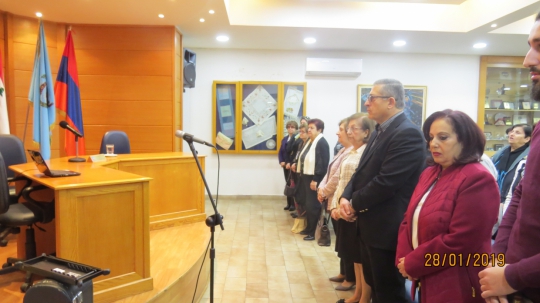Under the auspice of the regional board, and the organization of the educational committee of ARCL, a lecture event took place in “Tenjoukian Hall” of Araxi Boulghourjian socio-medical center on Monday, 28 Jannuary, 2019 at 10:30 a.m.
After listening to the march of ARS, Zepure Chaparian delivered the opening word in the name of the organizational committee by touching upon the subject of the lecture and highlighting the atrocities of the Armenian Genocide and the progress of the “Armenian cause”. The 1920-1960 period was called the period of preservation of the Armenian identity and the development of the diaspora. She defined the term “Armenian Cause” as the international recognition of the Armenian Genocide, and the uniting of the lands of Western Armenia, including Javakhk, Artsakh, Nakhijevan and eventually the return of all the lands to the Armenians. The “Armenian Cause” has historical, political and legal grounds. In order to politicize the “Armenian cause”, committees were organized. At this stage, the Turks made efforts to stop the activities of the “Armenian Cause”, but owing to the 95th article of the United Nations, the Armenians were able to convey the “Armenian Cause” to many countries and parliaments, and gain recognition from a large number of countries.
Afterwards, an artistic program was performed by Hovik Karakhanian who sang "Arax", "Yerevan" and "Ardashad" Armenian musical pieces, and Hagop Pambukian performed with guitar "Our Love Autumn" and "My brother and I".
At last, the member of the educational committee presented the biography of the lecturer doctor Hovhaness Taslakian and pointed out to his fruitful national, socio-public, partisan activities, and the activities related to the “Armenian cause”. She noted that doctor Taslakian participated in various conferences on national-political and international-political issues and invited him to present the "Armenian Cause Today" theme.
In the first part of the lecture, Dr. Taslakian presented the period of the First Armenian Republic which lasted about two and a half years, and that Turkey was in a state of war with Armenia before the “Armistice of Mudros”, after which Turkey surrendered to the allies and no longer existed as a sovereign state. There was a Turkish territory that had been given to the allies and there was The independent Republic of Armenia. Therefore, during that period there was no Turkish-Armenian relationship.
Then Dr. Taslakian said the relationship was between the Soviet Union and the Turkish Republic. After the declaration of independence, the borders were open for a while. However, in the Artsakh war, when Armenian forces entered Karvajar, Turkey tried to impose a term for the Armenian forces to withdraw from Karvajar, something which was not implemented. Consequently, Turkey closed the border.
Then the lecturer mentioned that today economic relations are developing, the air rout over Georgia is open, and any citizen of Armenia may travel to Turkey and buy products. The opposite is true as well, but unfortunately we do not have anything to sell ... so this trade is profitable for Turkey.
Dr. Taslakian emphasized on the fact that we are fighting for our rights, and our anti-Turkish stance, and generally our opposition to the Turks makes them oppose us as well, but political activity assumes that we create the prospect to communicate with them, explain our truthfulness and change the misrepresented notion found in the Turkish public opinion that the Armenians went against Turkey and then left the country.
Dr. Taslakian concluded his lecture and said that the battle between Armenia and Turkey being a political battle, we need more factors, and this process starts with the recognition of the Genocide.
And later there was a set of constructive questions and answers.



